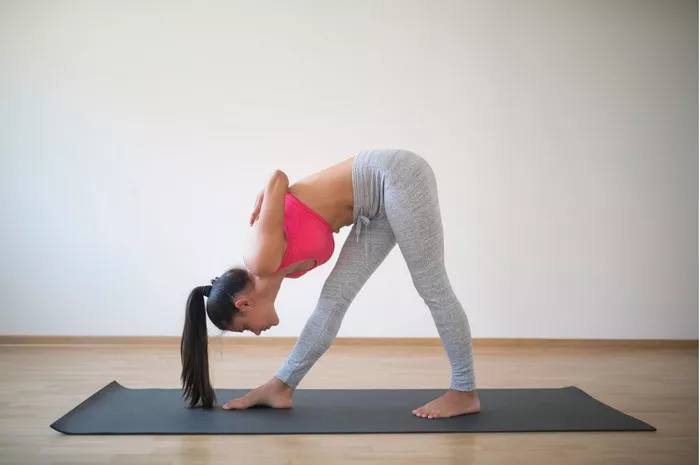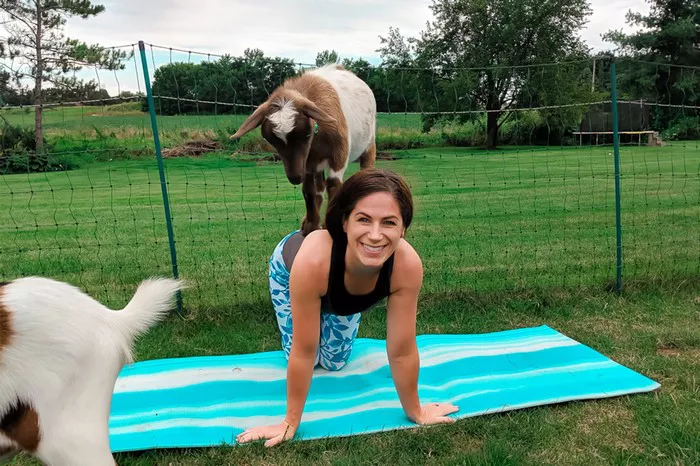Yoga, an ancient practice originating in India, encompasses a wide array of poses aimed at promoting physical and mental well-being. Among these poses is the Pyramid Pose, also known as Parsvottanasana in Sanskrit. This standing forward bend offers a multitude of benefits, both physical and mental, while also carrying profound symbolism rooted in yogic philosophy. In this article, we delve into the origins and symbolism of the Pyramid Pose, its physical and mental benefits, variations and modifications, step-by-step instructions, as well as precautions and contraindications to ensure a safe and fulfilling practice.
Origins and Symbolism
The Pyramid Pose finds its roots in Hatha Yoga, one of the most traditional forms of yoga practice. Its Sanskrit name, Parsvottanasana, can be broken down to “Parsva” meaning “side” or “flank,” “Uttana” meaning “intense stretch,” and “Asana” translating to “pose” or “posture.” The name itself signifies the intense stretch experienced along the sides of the body in this posture.
Symbolically, the Pyramid Pose represents stability, strength, and introspection. The pyramid shape, with its broad base and pointed apex, mirrors the idea of grounding oneself firmly while reaching upwards towards higher consciousness. It embodies the balance between strength and surrender, stability and expansion, making it a potent pose for both physical and spiritual growth.
Physical and Mental Benefits
The Pyramid Pose offers a plethora of benefits for both the body and mind. Physically, it stretches and strengthens various muscle groups, including the hamstrings, calves, hips, spine, and shoulders. The elongation of the spine in this posture helps improve posture and relieve tension accumulated from prolonged periods of sitting or standing.
Moreover, practicing Parsvottanasana stimulates the abdominal organs, aiding digestion and improving metabolic function. It also enhances circulation, bringing fresh oxygenated blood to the brain and extremities, which can help alleviate fatigue and promote mental clarity.
On a mental and emotional level, the deep forward fold of the Pyramid Pose encourages introspection and cultivates a sense of calm and focus. The symmetrical alignment of the body fosters balance and harmony within, promoting a feeling of centeredness and inner peace.
Variations and Modifications
Like many yoga poses, the Pyramid Pose can be modified to accommodate different levels of flexibility and experience. One common variation is the use of props such as yoga blocks or a chair to support the hands in the forward fold, allowing individuals with tighter hamstrings or limited mobility to experience the benefits of the pose without strain.
Another modification involves bending the front knee slightly to reduce the intensity of the stretch on the hamstrings. This variation, known as Ardha Parsvottanasana or Half Pyramid Pose, is particularly helpful for beginners or those recovering from injury.
For more advanced practitioners looking to deepen their practice, variations such as Parivrtta Parsvottanasana (Revolved Pyramid Pose) can be explored. This variation involves adding a twist to the traditional Pyramid Pose, further enhancing spinal mobility and stimulating the internal organs.
Step-by-Step Instructions
To practice Parsvottanasana safely and effectively, follow these step-by-step instructions:
- Begin standing at the top of your mat with your feet hip-width apart and arms by your sides.
- Step your right foot back about three to four feet, keeping both feet parallel to each other.
- Square your hips towards the front of the mat, ensuring that your left hip is not jutting out to the side.
- Inhale as you lengthen your spine, lifting your chest and rolling your shoulders back.
- Exhale as you hinge at the hips and fold forward over your left leg, keeping your spine long.
- Bring your fingertips or palms to the floor on either side of your left foot. If flexibility allows, you can place your hands on yoga blocks or a chair for support.
- Engage your quadriceps to gently straighten your left leg, feeling a deep stretch along the back of the left thigh.
- Keep your gaze directed towards your front foot and relax your neck and shoulders.
- Hold the pose for 30 seconds to one minute, breathing deeply and evenly.
- To release, inhale as you lift your torso back up, returning to standing position.
- Repeat on the opposite side, stepping your left foot back and folding over your right leg.
Precautions and Contraindications
While the Pyramid Pose offers numerous benefits, it may not be suitable for everyone, especially those with certain health conditions or injuries. Individuals with the following issues should exercise caution or avoid practicing Parsvottanasana altogether:
1. Hamstring Injury: If you have a hamstring strain or injury, avoid deep forward folds and opt for gentler stretches until the injury has healed.
2. High Blood Pressure: The intense forward fold in Parsvottanasana can temporarily increase blood pressure. Individuals with hypertension should practice with caution and avoid holding the pose for an extended period.
3. Low Back Pain: If you experience discomfort or pain in the lower back, bend your knees slightly or reduce the depth of the forward fold to avoid exacerbating the condition.
4. Vertigo or Balance Issues: Individuals prone to dizziness or balance problems should approach the pose slowly and use a chair or wall for support if needed.
5. Pregnancy: Pregnant individuals should consult with a qualified yoga instructor before practicing Parsvottanasana, as the deep forward fold may put pressure on the abdomen and pelvis.
Conclusion
In conclusion, the Pyramid Pose, or Parsvottanasana, is a powerful yoga posture that offers a myriad of physical, mental, and spiritual benefits. By exploring its origins, symbolism, variations, and safety precautions, practitioners can cultivate a safe and fulfilling practice that promotes overall well-being and inner harmony. As with any yoga practice, remember to listen to your body, honor its limitations, and approach each pose with mindfulness and intention.
FAQs:
What is the difference between pyramid and triangle pose?
The main difference between Pyramid Pose (Parsvottanasana) and Triangle Pose (Trikonasana) lies in their alignment and focus. In Pyramid Pose, the emphasis is on a deep forward fold with both legs straight, targeting primarily the hamstrings and spine. In contrast, Triangle Pose involves a lateral stretch with one leg extended sideways and the other foot grounded, focusing on opening the hips and elongating the side body. While both poses offer unique benefits, Pyramid Pose emphasizes forward folding and hamstring flexibility, while Triangle Pose emphasizes lateral stretching and hip opening.
Is Pyramid Pose a Hip Opener?
While Pyramid Pose primarily targets the hamstrings, it also offers some benefits for hip flexibility. As the pose requires squaring the hips towards the front leg, it gently stretches the hip flexors of the back leg. However, compared to other yoga poses like Pigeon Pose or Cow Face Pose, Pyramid Pose may not be as intense of a hip opener. Nevertheless, it can still contribute to overall hip mobility and flexibility when practiced regularly and with proper alignment.
What is the Sphinx Pose in Yoga?
Sphinx Pose (Salamba Bhujangasana) is a gentle backbend that helps stretch the spine, chest, and shoulders while also strengthening the muscles of the back. To practice Sphinx Pose, lie on your belly with your legs extended behind you and your elbows directly under your shoulders, forearms flat on the mat. Pressing into your forearms, lift your chest and gaze forward, keeping your shoulders relaxed away from your ears. Sphinx Pose is often used as a preparatory pose for deeper backbends like Cobra or Upward Facing Dog, or as a gentle stretch to alleviate tension in the lower back.























